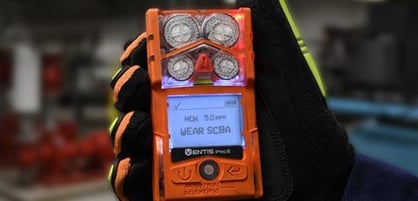Sulfur Dioxide (SO2) Gas Detectors
Sulfur dioxide (SO2) is a colorless, extremely toxic gas with a strong odor. Common applications of sulfur dioxide include sulfuric acid production, pulp and paper mills, chemical processing, food and beverage operations, and petroleum refineries. Because coal and petroleum often contain sulfur compounds, their combustion will generate SO2 unless sulfur compounds are removed before burning the fuel.
.webp?width=2000&name=Gas--%20(1).webp)
Characteristics of Sulfur Dioxide (SO2)
Sulfur dioxide (SO2) is a colorless gas with a characteristic, irritating, pungent odor. Sulfur dioxide is released when compounds containing sulfur, such as fossil fuels like coal are burned.
Sulfur dioxide is a highly toxic gas which poisons its victims via inhalation through the lungs. SO2 combines with water to form sulfuric acid (H2SO4). It is for this reason that sulfur dioxide can burn the respiratory tract upon inhalation. High doses of SO2 can cause death quite rapidly.
More about Sulfur Dioxide


SULFUR DIOXIDE - SO2
Effects of Various SO2 Levels
How to Detect Sulfur Dioxide (SO2)
To keep workers safe from sulfur dioxide (SO2) exposure—and other hazardous gases that may be present—Industrial Scientific offers a wide range of portable gas detectors, such as the Tango® TX1 and GasBadge® Pro single-gas detectors, the Ventis® Pro5, Ventis® MX4, and MX6 iBrid® multi-gas detectors, and the Radius® BZ1 Area Monitor.
Frequently Asked Questions
What is Sulfur Dioxide (SO2)?
Sulfur Dioxide (SO2) is a colorless gas with a pungent, irritating odor. It’s produced by burning fossil fuels and in various industrial processes, including metal smelting and the manufacturing of sulfuric acid.
Why is Sulfur Dioxide (SO2) detection important?
Detecting SO2 is vital for ensuring air quality and worker safety. SO2 can cause severe respiratory issues and environmental harm. Early detection helps prevent overexposure and ensures compliance with safety regulations.
What are the health effects of Sulfur Dioxide (SO2) exposure?
Exposure to SO2 can cause respiratory problems like coughing, shortness of breath, and aggravation of asthma. High concentrations can lead to severe lung damage and respiratory failure.
How do you detect Sulfur Dioxide (SO2)?
SO2 is detected using gas detection instruments such as portable, personal gas detectors and area monitors. These tools provide real-time monitoring to ensure safety and regulatory compliance in industrial environments. Industrial Scientific offers a range of SO2 detectors, including both monitors and gas detection software.

